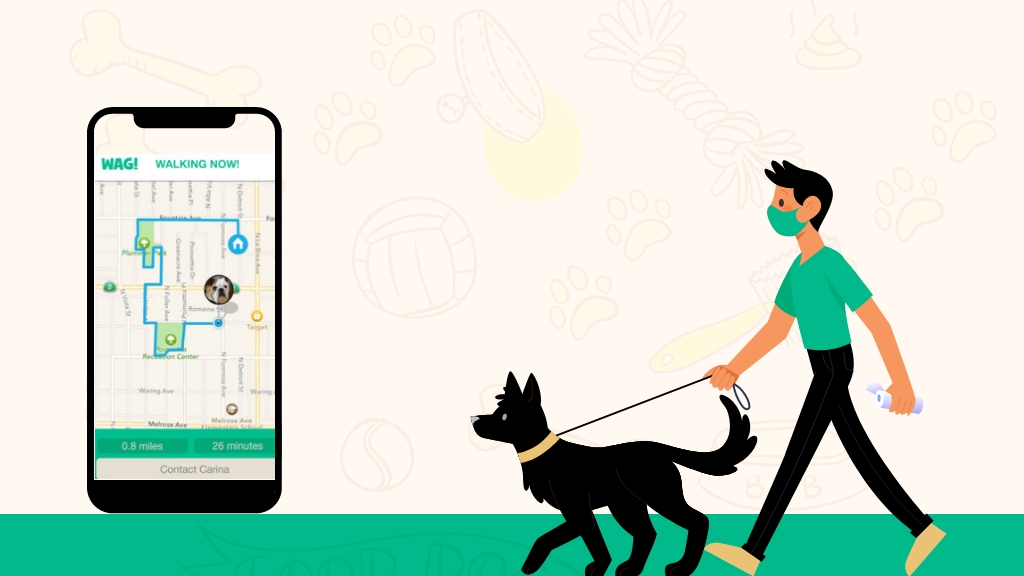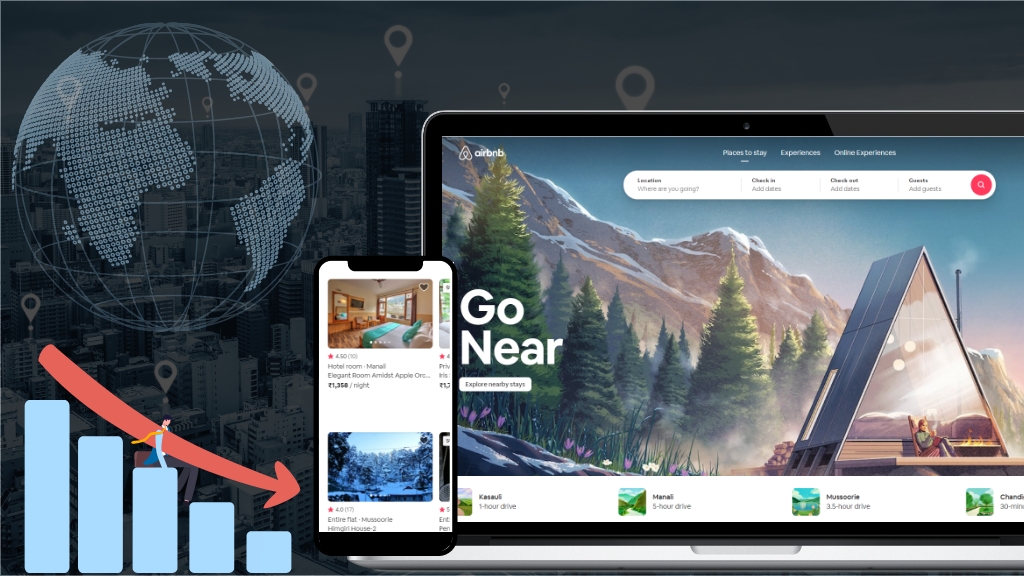Don't miss the chance to work with top 1% of developers.
Sign Up Now and Get FREE CTO-level Consultation.
Confused about your business model?
Request a FREE Business Plan.
Guide on How to Create Workout App like My Fitness Pal and Earn
Table of contents
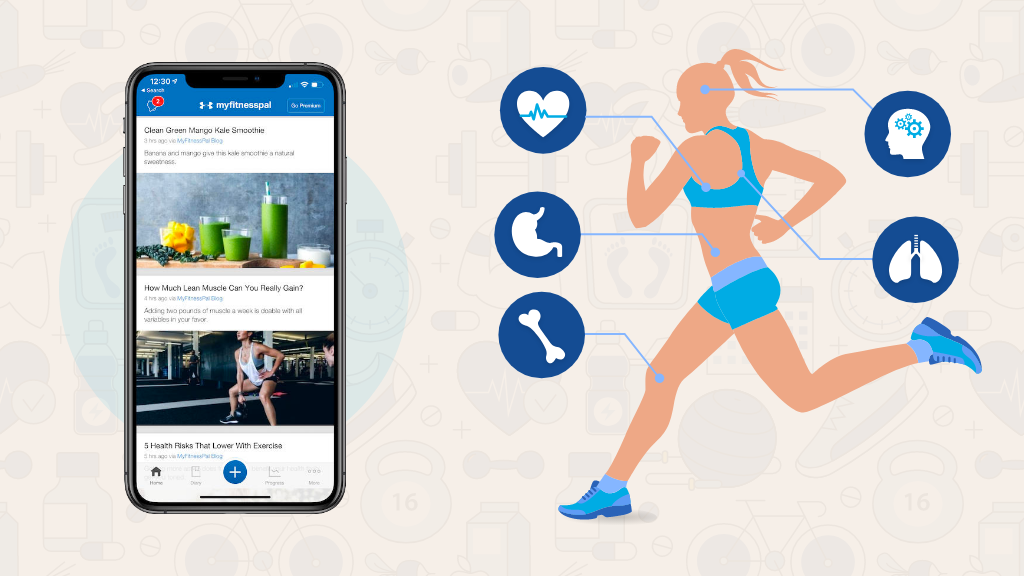
Health is the only wealth that stays with you forever. As we all in the present time are battling with the hard situations of Coronavirus, it has put us all under one light. How much we are aware of our body and immunity and what we can do to keep it healthy.
Since in lockdown people avoid going out and get home delivery services at their doorstep. They prefer to get all the services possible at the convenience of one hand. Be it having online appointment booking through the app or getting groceries delivered. So if all the things are working with technology, why not health services?
In this blog, we will learn why to create your own workout app and get into the fitness app development services. What is the scope and how you can earn from it?
Future of Fitness Tracker App
The fitness tracker app is getting momentum in the present times. The reason being, people are busy and doing sitting jobs at least 8 hours a day on an average. This is leading to high cholesterol, stress, and obesity in people. People want an easy option that helps them to feel healthy anytime and anywhere as per their convenience.
Fitness app solutions is in demand because due to the pandemic. People are avoiding to go in gyms or yoga centers. They want to get healthy at home with the guidance of experts and health tracking apps to provide the same. Here are some of the facts to acknowledge the same.
- The US stands top in healthcare spending with $10,224 per capita.-policyadvice.net
- The health searches contribute to 5% of total Google searches- Google
- Youngsters (age 18-24) are more involved with health-related issues and awareness through online mediums like social media. – Getreferralmd.com
- Around 19% of smartphone users have at least one health tracking app. It could be either related to diet, workout, nutrition, etc. – getreferralmd.com
- 64% of physicians say that IoT can aid to reduce the burden on nurses and doctors.-policyadvice.net
- The net worth of the health industry in 2018 was $8.45 trillion.- policyadvice.net
Therefore, it is quite evident that thinking of fitness app development is a great idea as it has good scope especially due to the pandemic.
But the fitness tracking apps are of different types that perform different functions. Let us learn what all are they so that you get better clarity.

Types of Health Tracking Apps
The health tracking apps vary from specialization to specialization. Different fitness tracking app deals with different functions that give an insight into the particular health aspect. However, the apps these days share lots of information and insights about your app.
The image below shows the different types of health tracking apps that you can consider for development.
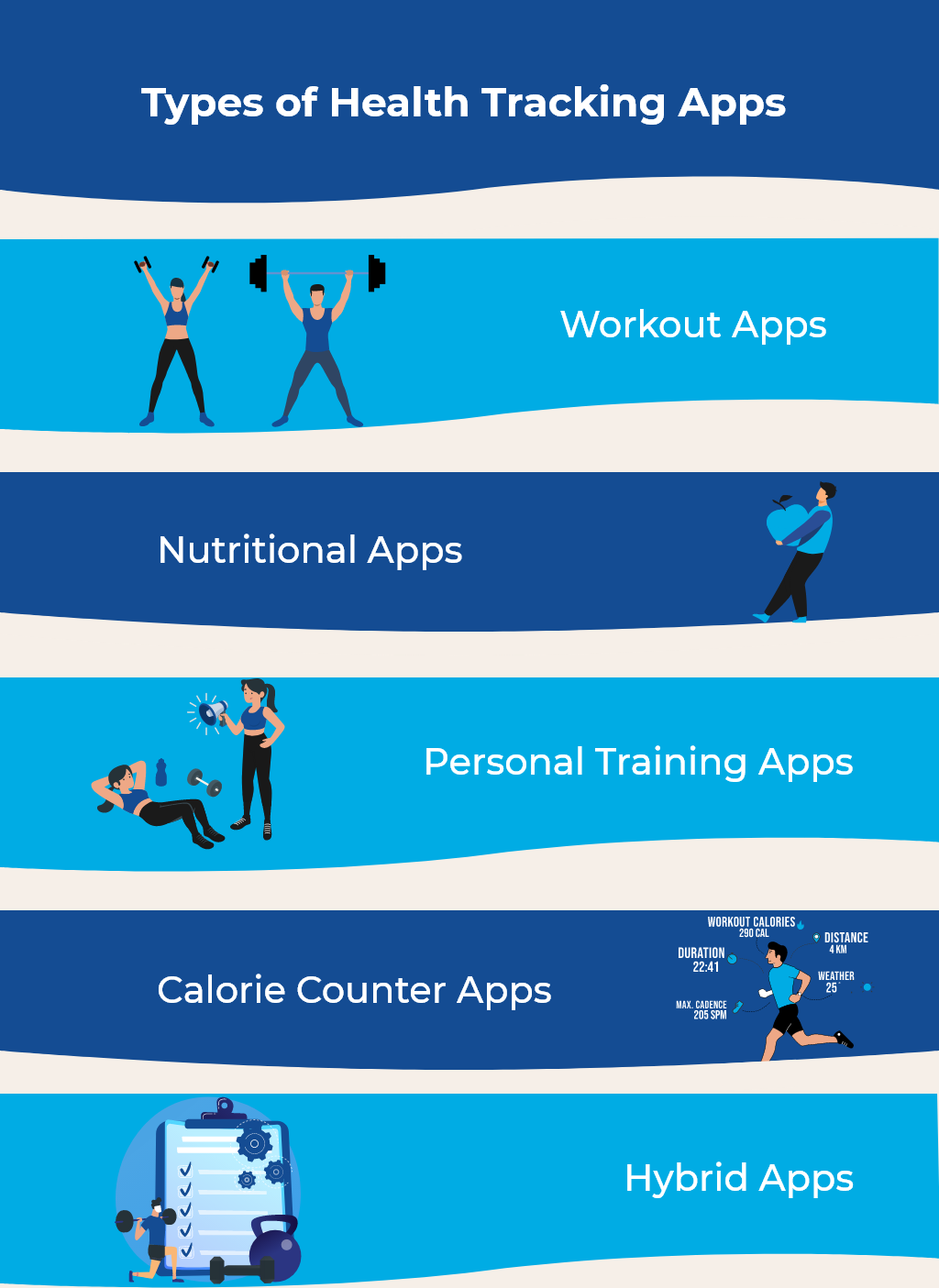
1. Workout Apps
In these kinds of apps, the main focus is on sharing information and training sessions for workouts. To create workout apps, you have to streamline the exercises for different body parts or the overall fitness of the person.
These apps show workout exercises through infographics or videos for a better understanding of the user. These apps could either be related to a specific training program like abs workout or slimming fat arm etc or could be for the whole body.
Some of the workout apps also have timers to perform particular workout activities in a specific time frame.
2. Nutritional Apps
The nutritional apps keep track of what you eat and what you should eat. It is basically a diet app that suggests to you what you should consider eating for a healthy body and lifestyle.
The user fills in the information and with respect to their age and BMI (body mass index) the food items are suggested.
These apps are high in demand as they help in maintaining a good balance in food quality that the user eats. It is also a good health tracking app to go for if you want to change your eating habits or focus to cure a particular problem area by good food intake.
3. Personal Training Apps
In these apps, you can actually feel like you are at the gym. The user is assigned a personal trainer. It could be either a real person or AI assistant that guides the user through their fitness journey.
Just like a regular trainer, this trainer in the health tracking app tells users what to eat, what workout exercises to do, and other activities they need to take up for a healthy lifestyle.
The guidance of the food and exercise are provided post health assessment. It is conducted after the information is fed by the user itself.
4. Calorie Counter Apps
It is quite similar to nutritional apps the only difference is that it is a self-guided take on healthy eating. In this, the user after filling in their information learns what is an optimum calorie intake they should have for their specified health goal.
The calories that are provided should be monitored with the food they eat and the physical activities they perform. The calories consumed are fed manually or by taking pictures of food. It all depends on the advancement level of fitness app development.
The calories burnt could either be fed manually or calculated by wearable gadgets.
5. Hybrid Apps
As the name suggests, it is a mix of all the apps that are mentioned above. In these apps, you get a personal trainer that suggest to you what food you should eat and what workout exercises the user needs to do to attain their specific health goal.
Also, along with that, these apps give you leverage to self-monitor yourself by doing calorie calculations through what food you eat and what you burn through the medium of workout. Therefore, the fitness app development for such an app includes all the features and functionality of all other apps altogether.
Essential Features to Create Workout App Like My Fitness Pal
Now, as we have learned about the types of fitness apps. I hope it might have given you a major clarity upon which category to choose for fitness app development. But have you ever wondered what are the features you need to include to create a workout app? Here are some main functionality features one should consider.
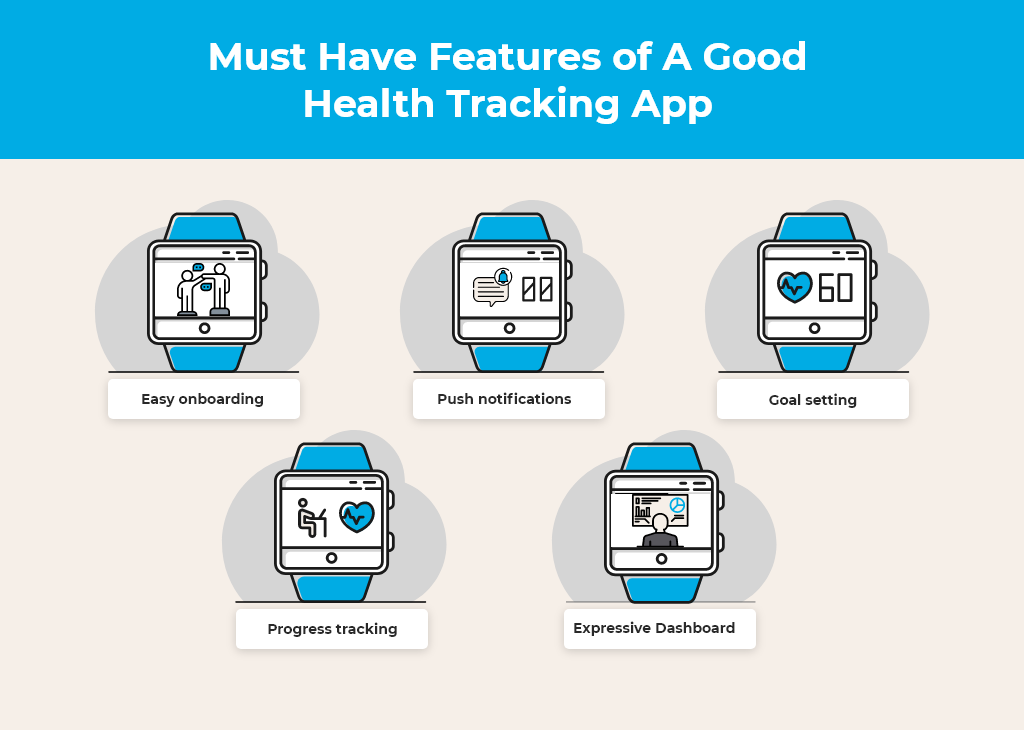
Let us decode each of them in detail.
1. Easy onboarding
When the person logins in or sign up for the app. The process of doing it should be very simple. The logging in or signing up should be done by simply social media integration or filling in either mobile number or email credentials.
After the sign-up is done, logging in to the app every time over the same phone should be easy with a single tap. The onboarding for the personal trainers (if you create a workout app that includes personal trainers) should also be easy.
They can log in at their panel of PT with the same process and handle the clients. And you being the user of the admin panel should be able to log in to the app and learn all the necessary information required.
2. Push notifications
The push notifications are very important for the person who runs the admin panel in the health tracking app. Admin panel is very important as it regulates the whole app and learns the insights of the users and the personal trainers attached to the app.
The push notification button allows the admin to send customized notifications to the users and personal trainers regarding the discounts, special offers, or new programs and features they want their target audience to enroll in.
The admin can send this message with just one click to all their users or a selected group of people altogether without bothering any other development functionality.
3. Goal setting
Everyone signs up on a fitness tracking app with a goal. The goal to get fit and healthy. Some people come with a goal for weight loss, some to cure any health disease, or some for regular body health.
Enabling feature that lets a user set their goal with respect to their requirement increases the friendly user experience for the users. They feel that the app understands them and based on their filled information provides them customized health solutions.
4. Progress tracking
As said above goal setting is an important feature. It allows users to learn what they have to achieve. Similarly, the feature of progress tracking is also equally important.
The progress tracking feature each day shows how much the user has done to reach the target. This acts as a motivation for the user as they can see and learn what and how much more they have to do to get the desired result.
The progress could be either tracked by wearable gadgets or by manual feeding. In the calorie counter and diet apps, the users have to feed by themselves for knowing their progress about the estimated calorie intake.
5. Expressive Dashboard
The dashboards are the windows to the user where they can learn about what to do, how to do it, and then track their progress. The dashboard of the user, the personal trainer, and the admin panel should be explainable by the easy app navigation and extra friendly user interface.
The dashboard should be easy to understand so that the user while browsing the app should be able to know how to set their profile and what are their current progress respect to the given goal.
Read More: How to Develop a Health and Fitness App [Detailed Guide + Cost]
Ways of Monetization after Fitness App Development
So up till now, we are aware of the different kinds of fitness tracking apps. What are the main functionality features one would consider while doing a fitness app development and what are the scopes attached to it.
Let us now learn how you can create a workout app and earn a lot from it in different ways. The broad categories in which you can monetize your fitness tracking app are as follows.
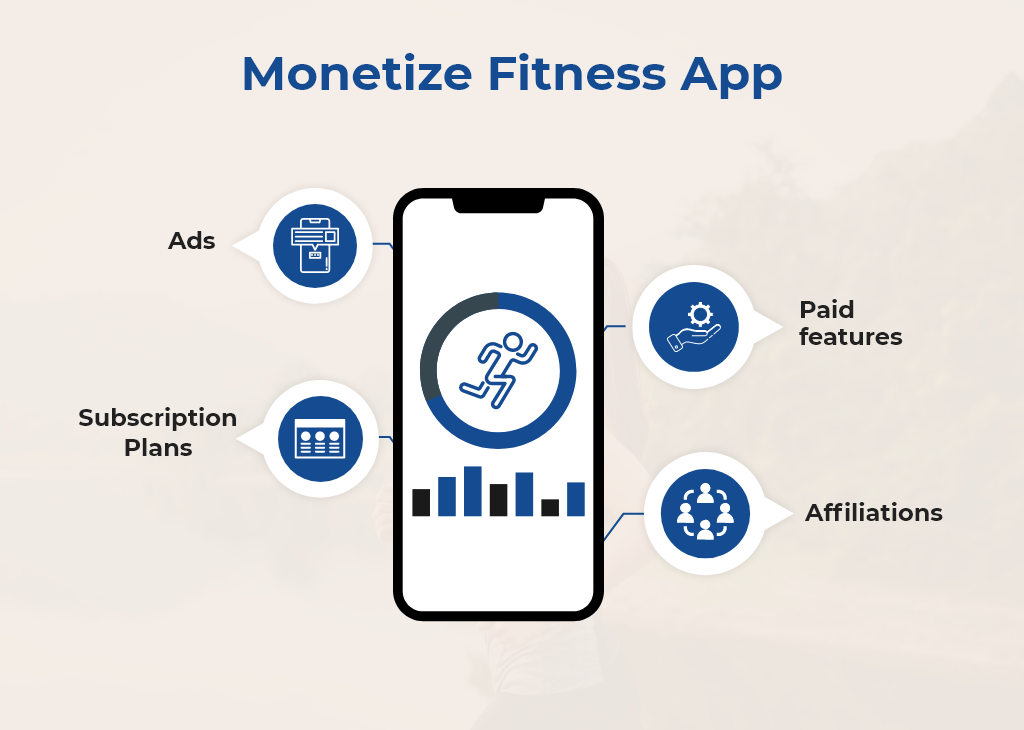
Let us have a look at how one can generate revenues from them.
1. Ads
Get sponsorships from other brands and products and show their ads. You can show their ads in the middle of the workout process or in form of ad posters located somewhere at your mobile app layout.
By promoting the ad of some other brand over your app, it will give you an extra source of income. The popular your app gets, the more you will be given offers to promote ads of other parties. So showing ads on your app is a good way of generating money.
2. Subscription Plans
Subscription plans are wholesome packs of services that are provided to the user at the lumpsum amount. It is the kind of way to entice your users to get more features and facilities at lesser prices.
For example, your app provides custom diet charts at 50 US dollars per month. In subscription plans, you can provide the same services for 3 months at 125 US dollars and for 6 months at 250 US dollars.
Thus, the user has an option to choose on the go plan or any other plan that saves them money and provides you lumpsum big amount from the user all at once!
3. Paid features
The best way to earn revenue from your app is by keeping some standard features for free and the rest of the others paid. Show the functionality of your app and its effectiveness by providing free trials or keeping some features free.
Once the user is interested in your app, they will be willing to exploit the features of the app even by paying the amount for them.
For example, the app provides workout sessions through videos or infographics, once the user is inclined towards the app, you can pitch for personal trainer workout sessions that are paid. You can also incorporate subscription plans for the same.
4. Affiliations
Affiliate marketing is very much like an ad promotion that we already talked about in the first point. The only difference in ad promotion we get a fixed amount. Whereas in the affiliations, the one who is promoting gets a certain percentage of the profits earned by the product that is getting promoted.
You can also go for affiliation for the complementary apps. Like if you have made a workout app for yourself you can go with an affiliation with a diet app or any other fitness tracking app that complements your function.
Conclusion
The fitness tracking app is the need of the hour. People are at home, working over laptops, and having a lazy lifestyle. They are getting aware of the importance of being fit and are searching out for options that provide them assistance to maintain their health. If you are looking for best fitness app development company, you can hire us.
In a pandemic scenario, online fitness tracking apps are a great help. It aligns with social distancing norms and yet assists people on how to keep themselves healthy and fit. Therefore, to make an app like My Fitness Pal stands a chance of getting hit.

Rate this article!
(4 ratings, average: 1.25 out of 5)
Join 60,000+ Subscribers
Get the weekly updates on the newest brand stories, business models and technology right in your inbox.

An avid reader and non-traditional thinker. Aayushi started her career at age of 22 which allowed her to write about the latest trends and technology that are new in the market. Identifying herself as a mobile geek, she finds pleasure in exploring apps and trends in the Mobile industry. Commerce graduate and Masters in Finance, she is well versed with aspects of what it takes for any brand to mark its position in the market. Being a certified Content marketer and influencer from HubSpot; she is familiar with brand positioning and the latest trends running in the IT and Digital world.

App Monetization Strategies: How to Make Money From an App?
Your app can draw revenue in many ways. All you need to figure out is suitable strategies that best fit your content, your audience, and your needs. This eGuide will put light on the same.
Download Now!Take the First Step
Towards Success!
Master app development with a
30-day FREE trial of our premium
solutions.
